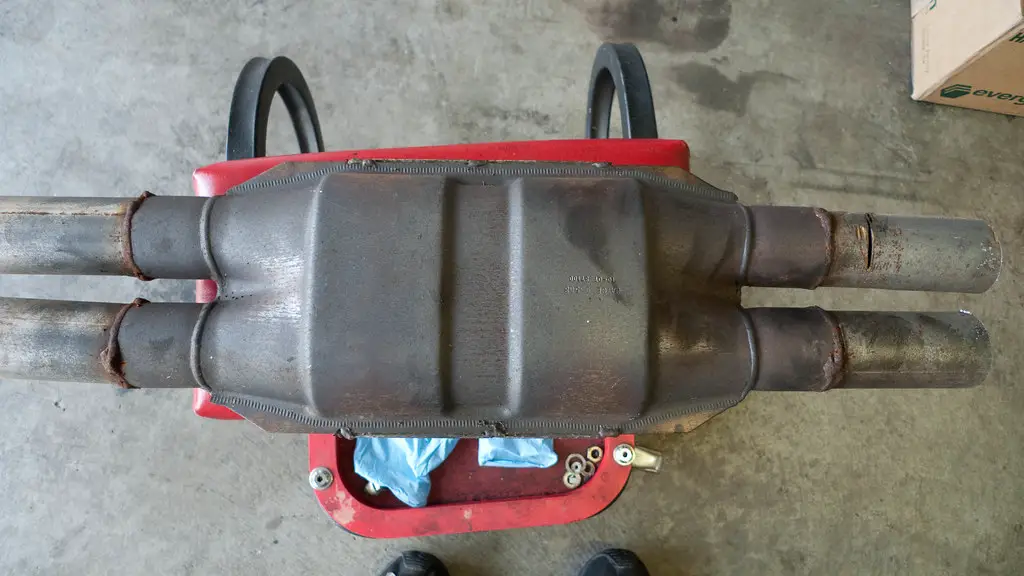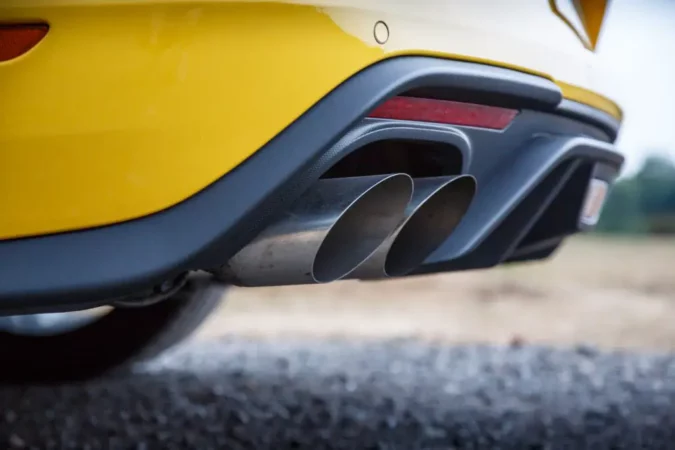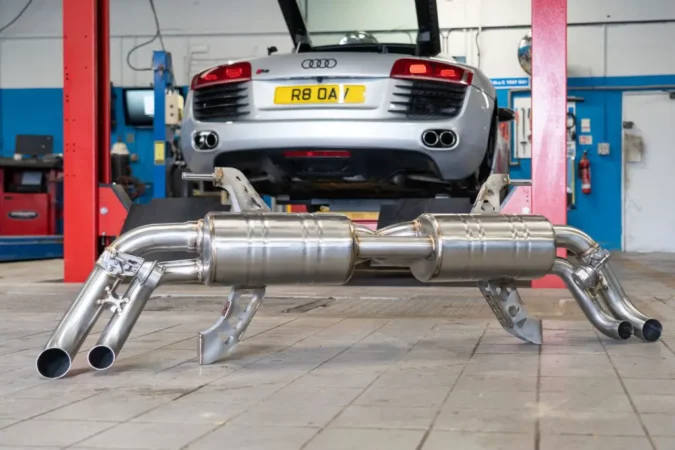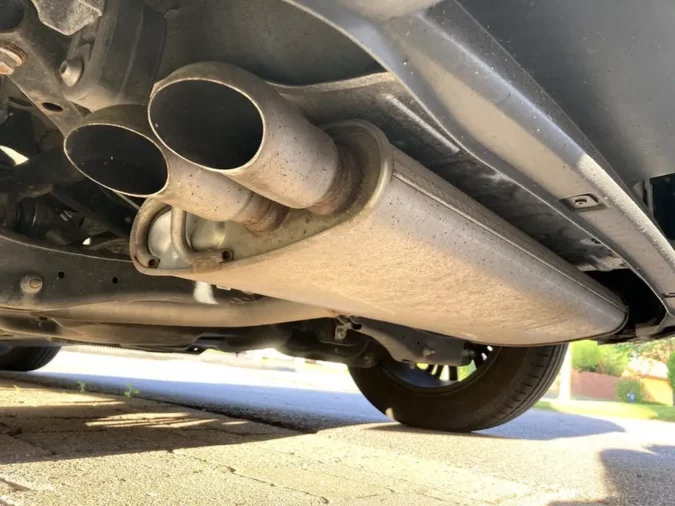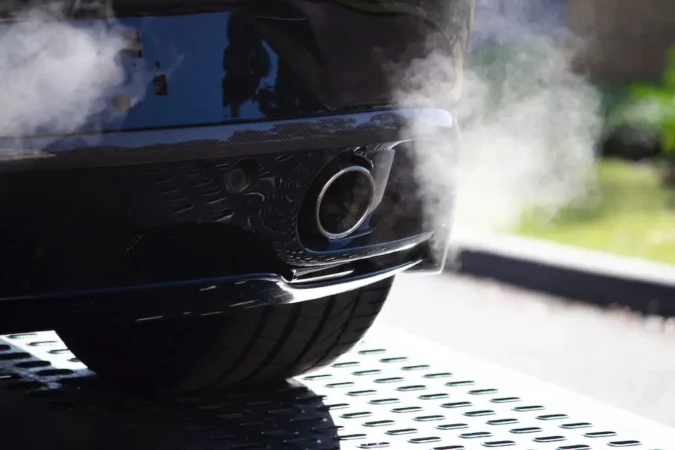The exhaust system is one of the most important components in any vehicle. It is responsible for disposing of the harmful exhaust gases of your engine. In addition, the exhaust system removes a significant amount of toxicity from these gases before releasing them. Vehicles use catalytic converters (aka the “cat converter”) for this task. But, do all cars have a catalytic converter?
Today, we’ll take you on a tour where you’ll learn all about what the catalytic converter is, how it functions, as well as other essential facts. Not only that, we’ll tell you all about repair costs associated with the catalytic converter too.
Before looking at the catalytic converter up close, we thought of telling you more about a vehicle’s exhaust system. This will help you learn more about how the catalytic converter fits into this system as a whole. So, without further ado, let’s get started!
Car Exhaust System
As we already mentioned, the exhaust system is one of the most important mechanisms in a car. It has several responsibilities, which include removing harmful elements, reducing the exhaust note as well as purifying the exhaust gases to an extent.
The exhaust system of a vehicle is made up of a collection of different components. Each of these fulfills a different role. It is important for any gearhead to have a clear understanding of these components.
The key elements of a car exhaust system are,
- Exhaust Manifold
- Oxygen Sensors
- Muffler
- Exhaust Pipes
- Tailpipe
Car Exhaust System #1 – Exhaust Manifold
The exhaust manifold is the frontmost part of a vehicle’s exhaust system. As you already know, the engine block is where the internal combustion process takes place. The exhaust manifold connects directly to the engine block, collects all the fumes, and directs them toward the other components down the line.
In other words, the manifold is what connects the engine to the exhaust system. To learn more, we’ve previously discussed the cost of replacing the exhaust manifold, what is an exhaust manifold repair, and why is there an exhaust manifold leak.
Due to its location, the exhaust manifold has to endure an extreme amount of heat. To compensate for this, manufacturers use highly durable cast iron metal to construct this component. It is important to ensure that this manifold stays completely sealed. Otherwise, toxic fumes might leak into the passenger compartment and cause an array of health issues.
In addition to being a health hazard, malfunctioning exhaust manifolds may lead to other mechanical issues as well. It will put fatigue on the exhaust valves, resulting in cracks and even complete failure. Broken exhaust valves are one of the leading causes of engine performance issues.
Car Exhaust System #2 – Oxygen Sensors
Almost all modern vehicles come equipped with two oxygen sensors. These sensors electronically measure the oxygen composition of exhaust gases leaving the engine.
You can find the upstream oxygen sensor situated right before the catalytic converter. Data from this sensor is used by the vehicle’s onboard computer to regulate the engine’s air/fuel mixture. This reading has a significant effect on the fuel economy of your vehicle.
On the other hand, the downstream oxygen sensor can be found after the catalytic converter. The PCM (powertrain control module) uses this sensor’s data to monitor the health of the catalytic converter.
Overall, having good oxygen sensors is essential for any vehicle. Otherwise, you won’t have a clue about what’s emptying your fuel tank, or why your car fails emissions tests constantly.
Car Exhaust System #3 – Muffler
In addition to purifying toxic fumes, the exhaust system has to be worried about the sound of the engine as well. This is why it is important. Quietening down the exhaust note is the main responsibility of the muffler. Some people also use the word “silencer” to refer to this component.
The muffler is located toward the back of the exhaust system. The insides of mufflers are lined with materials that can absorb noises. In addition, there are perforated tubes and chambers inside the muffler too.
When sound waves are directed through them, it creates opposing sound waves. This helps to cancel out the unnecessary engine sound. For more insight, check out our guides on what is a muffler repair, where to get a muffler delete near me, and how much is for a muffler replacement, how much is a muffler repair cost, as well as why is there a hole in the muffler.
In addition to the mufflers, some performance cars also come with exhaust resonators. These are typically located toward the front of the muffler. Instead of quieting down the exhaust note entirely, the resonators remove only the ‘annoying’ frequencies. This allows performance cars to retain their signature exhaust notes while not being a menace to the environment.
Car Exhaust System #4 – Exhaust Pipes
The exhaust pipes can be considered the backbone of the entire exhaust system. Most vehicles come from the factory with simple connector pipes for the exhaust. So, there are considerable performance improvements to be gained by replacing them.
You can find aftermarket downpipes, mid-pipes, and tailpipes in abundance out on the market. The wide diameter of these pipes along with the mandrel-bent tubing helps the exhaust gases to flow faster, thus increasing the performance.
Car Exhaust System #5 – Tailpipe
The tailpipe is where the vehicle releases exhaust gases into the atmosphere. The tailpipe and its tip start from the muffler and come out through the rear bumper.
In recent years, exhaust tip modification has become a real phenomenon. You can find all sorts of exhaust tips out in the environment – once that looks cool, make the car sound good, or improve overall performance.
Now, you know all about the major exhaust system components – except one. Can you guess what we are talking about? Yes, we are of course talking about the reason behind this article – the catalytic converter itself.
Are you keen to learn more about the catalytic converter? If so, follow us along to the next section.
Catalytic Converter
Before you learn the answer to “do all cars have a catalytic converter?” it is important to understand what this valuable component is. First of all, let’s try and understand the purpose of the catalytic converter.
We can thank the Clean Air Act as well as the Environmental Protection Agency for making the catalytic converter a mandatory component on all automobiles. In fact, driving a vehicle without a catalytic converter on public roads is an act that can get you into trouble with the law.
As we mentioned several times, converting harmful emissions from the exhaust system into not-so-toxic elements is the main purpose of the catalytic converter.
Some people have the misconception that diesel-powered vehicles don’t need a catalytic converter. But, this is not true.
Both diesel and gas-powered vehicles come from the factory equipped with catalytic converters. However, there are a few differences in the ways they operate.
Generally, you don’t have to worry much about the longevity of your vehicle’s catalytic converter. It is designed to last for the lifetime of the vehicle. Yet, as the theft of catalytic converters has skyrocketed in recent years, there might be incidents where you’ll have to replace them. Otherwise, it’s also handy to have a DIY catalytic converter protection.
All fuel-injected cars are outfitted with catalytic converters. This has been the norm since the mid-1970s. In fact, there are some cars on the market that have more than one catalytic converter. There may be several reasons for this type of configuration.
One reason for having multiple catalytic converters is that the car has a dual exhaust system. These systems are usually found on performance vehicles (in addition to a high-flow catalytic converter or an S2000 catalytic converter and the high flow catalytic converter Magnaflow or Evan Fischer catalytic converters). As the catalytic converter works in conjunction with the exhaust pipe, cars with multiple functional exhausts have to have two catalytic converters.
Do All Cars Have A Catalytic Converter
All cars with an internal combustion engine are required to have a catalytic converter by law. This rule has been in place since 1975. So, if you want to purchase a gas-powered car without a catalytic converter, the only options are vehicles built before that period.
However, there is another type of more modern car that lacks a catalytic converter. Can you guess what we are talking about? Yes, we are of course talking about electric cars.
You see, electric cars generate power through batteries, and lack any kind of fuel-burning powerplant. Due to this reason, they don’t produce any harmful emissions. As we have already established, there is no need for a catalytic converter if your car doesn’t produce any harmful emissions.
Catalytic Converter Theft
You might be surprised to hear this, but the catalytic converters are some of the most frequently stolen parts on a vehicle (to learn more, check out our guide on whether can I drive with a stolen catalytic converter, as well as the Hyundai Sonata catalytic converter theft). A report from the National Insurance Crime Bureau shows that crimes of this nature have seen an unprecedented 1215% increase since 2019.
But, what makes the catalytic converters a prime target for thieves and why are people stealing catalytic converters and why do they steal catalytic converters? Why do they love to steal this specific part (and why do you need to worry about catalytic converter theft prevention)? We’ll give you the answers to all these questions in this section.
Catalytic Converter Theft #1 – What Makes Them Valuable
In order to understand why catalytic converter theft has become such a common occurrence in recent years (you can learn more in our guide on the F-150 catalytic converter anti-theft and how to know if catalytic converter is stolen), first we have to look at what makes them so valuable. So, why are catalytic converters so valuable?
Many precious metals such as platinum, palladium, and rhodium are present inside catalytic converters. These act as catalysts (to find out more, check out our explainer on what’s inside a catalytic converter), and are responsible for breaking down the harmful toxins to emissions less violent.
Although these metals are present in minute amounts, their value of them is still significant. For example, an ounce of Platinum costs around $900. At its peak in 2011, the value of Platinum was set at an astronomical $1700 per ounce.
The same stands true for Rhodium as well. On average, an ounce of this precious and rare metal costs closer to $18,000. Similarly, the cost of Palladium is also high, standing at $2000 per ounce.
When taking these values into consideration, it is easy to see why catalytic converter theft has gotten so common (including numerous cases of catalytic converter theft in Texas). Depending on the type of “cat” they steal, thieves can earn anywhere from $150 to $1500 (this helps to explain why do people steal catalytic converters).
After stealing, the thieves usually sell these parts to scrapyards. Then, the catalytic converters will be stripped of the metals. These metals are then sold once again for profit. This explains why are catalytic converters being stolen and why do catalytic converters get stolen.
Now you know exactly why thieves target catalytic converters. Depending on the type of vehicle you drive, you might be more or less vulnerable to catalytic converter theft. But, which vehicles are the most vulnerable?
Catalytic Converter Theft #2 – Vulnerable Vehicles
The vulnerability of vehicles to catalytic converter thefts depends on two factors. The first one is the popularity of the vehicles. Obviously, vehicles that are more commonly found on the road have a high chance of getting their catalytic converter getting stolen (and the importance of learning how to prevent catalytic converter theft and how to stop catalytic converter theft).
The other factor is the ease of access. Although all vehicles have catalytic converters located on the underbelly of the vehicle, some vehicles allow outsiders to access them more easily than others.
Taking both factors into consideration, here are four of the most vulnerable vehicles for catalytic converter theft.
- Hybrid Vehicles
- Sedans
- Pickup Trucks
- SUVs
Let us go through each type of vehicle, listing out which cars are most likely to have their catalytic converter stolen, and see what makes them so inviting for catalytic converter thieves (this explains why catalytic converter theft is a thing).
Vulnerable Vehicles #1 – Hybrid Vehicles
According to the National Insurance Crime Bureau (NICB), Toyota Prius models made from 2001 all the way to 2021 are some of the most vulnerable to this kind of theft. In fact, it is the most targeted vehicle for catalytic converter theft in the whole of the Western United States.
Also, for more insight, check out our guide on does insurance cover catalytic converter theft. One of the major reasons for this is that catalytic converters of hybrid vehicles are more valuable than others.
Unlike conventional gasoline engines, hybrid engines do not run all the time. Due to this reason, there is less heat produced overall.
To compensate for this, manufacturers equip hybrid catalytic converters with more precious metals. With that, it is obvious to see just why thieves love to steal catalytic converters off of hybrids (to learn more, check out our guide on why steal a catalytic converter).
Vulnerable Vehicles #2 – Sedans
For years, sedans were the most popular vehicle body style among consumers. As these were found in abundance all over, it made them a prime target for catalytic converter thieves.
According to some research, sedan models that are targeted by catalytic converter thieves the most include,
- Honda Accord
- Toyota Camry
- Chrysler 200
- Nissan Altima
- Dodge Avenger
- Chevrolet Cruze
If you own one of these sedans, make sure to keep an eye on your catalytic converter. You never know when it might be gone!
Vulnerable Vehicles #3 – Pickup Trucks
Next, let’s shift our attention toward the third vehicle type that gets its catalytic converters stolen the most – pickup trucks. Just like sedans, the explosion in the popularity of pickup trucks is a leading cause for this increased vulnerability.
The Ford F-Series and the Chevrolet Silverado are two of the most popular pickup trucks currently on sale.
So, it shouldn’t surprise you to find out that these two are some of the most targeted vehicles for catalytic converter theft.
Apart from the sheer volume of these trucks on the road, their high ground clearance also contributes to this issue as well. Thanks to their lifted suspension, thieves can easily slide under the bed and extract the catalytic converter in a few moments.
Vulnerable Vehicles #4 – SUVs
All the above points about pickup trucks can be applied to SUVs as well. Just like their bed-equipped cousins, SUVs are found in abundance in almost every part of the world. This makes them an easy target for catalytic converter thieves.
According to the NICB, here are some of the most common SUV-shaped victims of catalytic converter thieves.
- Honda CR-V
- Subaru Outback
- Honda Element
- Jeep Patriot
- Chevrolet Equinox
Catalytic Converter Theft Prevention
Now, that you know the dangers of catalytic converter theft, here are a few tricks you can try to prevent this from happening to your car.
- Shields
- Straps & Cables
- Alarms
- Stickers
Catalytic Converter Theft Prevention #1 – Shields
If you want to prevent catalytic converter theft at all costs, a shield is the best way to go. These are typically made from stainless steel or aluminum. The shield encases the catalytic converter in all directions. This prevents thieves from accessing and stealing it (to find out more, check out our guide on why are they stealing catalytic converters).
Some catalytic converter shields even come with tamper-proof screws for additional protection. However, one major downside of catalytic converter shields is the high cost. Although, you can save some money by having a muffler shop build a custom shield for you (and figuring out how to protect your catalytic converter).
Catalytic Converter Theft Prevention #2 – Straps & Cables
You can also use cables and straps to secure your catalytic converter. The main goal behind doing so is implementing a physical barrier between the thieves and the converter.
All you have to do is to surround the catalytic converter with a network of straps and cables. But, this is easier said than done. In addition, a thief will be able to easily get through this barrier easily using a wire cutter.
Catalytic Converter Theft Prevention #3 – Alarms
Although catalytic converter alarms cannot prevent theft from happening, they can still warn you before it is too late. These use vibrations and motion to detect suspicious activity.
Most catalytic converter alarms are universal. This allows them to be fitted onto many types of vehicles. Not only that, but it allows for keeping the overall costs down as well.
The main downside of catalytic converter alarms is their fragility. This is due to the alarms consisting of several electronic sensors which are prone to failure.
Catalytic Converter Theft Prevention #4 – Stickers
The final and most cost-effective theft prevention method is using stickers. These act as a deterrent to potential thieves. But, there is no guarantee of success when using stickers. So, it is better to pair these with some additional theft prevention methods.
But, there can be some situations where all of these theft prevention methods prove to be ineffective. What should you do if your catalytic converter has been stolen?
Your first course of action should be to notify the authorities. The police will document the incident, and follow up on any evidence or leads. Next, go ahead and file a claim with your insurance company. Catalytic converters are expensive to replace, and your insurance company can help you to cover the price of a new catalytic converter (and bearing in mind replacing catalytic converter in California and a 2013 Audi A4 catalytic converter) and want to rely on the catalytic converter price lookup tool.
Although it is possible to drive your vehicle without a catalytic converter, it is illegal according to the law. So, removing the catalytic converter is a bad idea. Not only that but doing so is harmful to the environment as well. Just make sure you’re wary of the price of a new cat converter.
Catalytic Converter Cost
The cost of replacing the catalytic converter varies based on the type of vehicle you drive. So, how much for catalytic converter? On average, the cost of replacing the catalytic converter ranges between $900 – $3500. This includes around $2000 in labor costs and an additional $2000 for the replacement catalytic converter.
For more insight, check out our guide on how much does a catalytic converter cost. Granted, there are alternatives to replacing damaged “cats”, if you know how to fix a catalytic converter without replacing it. Otherwise, it’s worth taking into account the replacement cost of a catalytic converter.
Catalytic Converter Symptoms
Catalytic converters are designed to last the lifetime of a vehicle. But, there can be occasions where it fails prematurely. A few symptoms of a failed or damaged catalytic converter, signs of a bad catalytic converter (and learn how to tell if catalytic converter is bad), as well as the common symptoms of a clogged catalytic converter, include,
- Startup Issues
- Check Engine Light Turning On
- Failed Emissions Test
- Poor Fuel Economy
- Bad Acceleration
If you are experiencing any of these issues, we recommend you take your vehicle to a qualified mechanic as soon as possible.
You might have to resort to learning how to unblock a catalytic converter. The latter might not necessarily require a visit to a workshop, as there are plenty of catalytic converter cleaner solutions (or even using lacquer thinner as a catalytic converter cleaner) that you can buy.
Verdict
All in all, it is safe to say that all cars powered by internal combustion engines have catalytic converters. Only classics made before 1975 and modern electric cars come from the factory without this crucial element.
If your car comes with a catalytic converter, make sure to keep an eye out for potential thieves. Consider investing in a catalytic converter shield, some straps, cables, or an alarm as precautionary measures.
Frequently Asked Questions
Finally, let us have a look at some frequently asked questions on the topic “do all cars have a catalytic converter?”
Why Do People Steal Catalytic Converters
People steal catalytic converters because they contain precious metals like Platinum and Rhodium. The value of a stolen catalytic converter ranges from $50 to $500.
What Is A Catalytic Converter
The catalytic converter is one of the main components of the exhaust system. Its main responsibility is removing harmful toxins from the engine’s exhaust gases.
How Much Is A Catalytic Converter
The price of catalytic converters depends on your vehicle. The price of this component ranges from $900 for a basic one all the way to $3500 for a high-end part.
What’s Inside A Catalytic Converter
The internals of a catalytic converter contains a large honeycomb structure. Furthermore, it is covered in a thin coating made up of precious metal particles. Palladium, Rhodium, and Platinum are some metals used to coat the internals.
Can You Drive Without A Catalytic Converter
It is possible to drive a car without a catalytic converter. But, this is an illegal practice. Furthermore, driving around without a catalytic converter releases harmful toxins to the environment as well.

